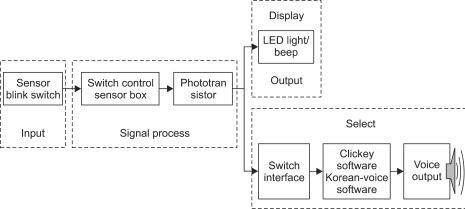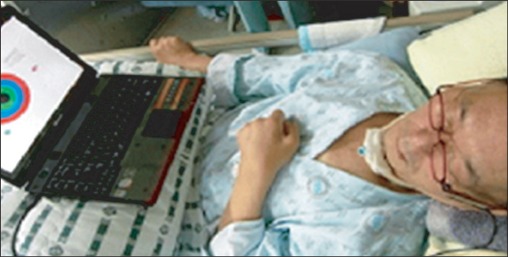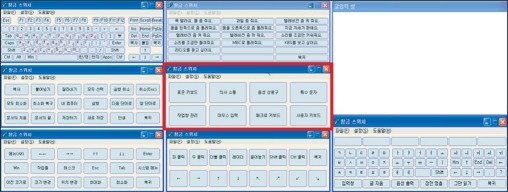Ann Rehabil Med.
2012 Apr;36(2):268-272. 10.5535/arm.2012.36.2.268.
Augmentative and Alternative Communication Training Using Eye Blink Switch for Locked-in Syndrome Patient
- Affiliations
-
- 1Department of Rehabilitation Medicine, National Rehabilitation Center, Seoul 142-884, Korea. drwgy@naver.com
- 2National Rehabilitation Center Research Institute, Seoul 142-884, Korea.
- KMID: 2266767
- DOI: http://doi.org/10.5535/arm.2012.36.2.268
Abstract
- Locked-in Syndrome is a severe pontine stroke causing quadriplegia, lower cranial nerve paralysis, and mutism with preservation of only vertical gaze and upper eyelid movement in a conscious patient. We present a case of a Locked-in Syndrome patient who received communication training with augmentative and alternative communication equipment by using eye blinks. After 3 weeks of training, the patient was able to make an attempt to interact with other people, and associate a new word by Korean alphabet selection. Augmentative and alternative communication equipment which uses eye blinks might be considered to be beneficial in improving the communication skills of locked-in syndrome patients.
Keyword
MeSH Terms
Figure
Reference
-
2. Patterson JR, Grabois M. Locked-in syndrome: a review of 139 cases. Stroke. 1986; 17:758–764. PMID: 3738962.
Article3. Doble JE, Haig AJ, Anderson C, Katz R. Impairment, activity, participation, life satisfaction and survival in persons with locked-in syndrome for over a decade: follow-up on a previously reported cohort. J Head Trauma Rehabil. 2003; 18:435–444. PMID: 12973273.4. Casanova E, Lazzari RE, Latta S, Mazzucchi A. Locked-in syndrome: improvement in the prognosis after an early intensive multi-disciplinary rehabilitation. Arch Phys Med Rehabil. 2003; 84:862–867. PMID: 12808539.5. Söderholm S, Meinander M, Alaranta H. Augmentative and alternative communication methods in locked-in syndrome. J Rehabil Med. 2001; 33:235–239. PMID: 11585156.
- Full Text Links
- Actions
-
Cited
- CITED
-
- Close
- Share
- Similar articles
-
- Awareness and Needs on Augmentative and Alternative Communication of Critical Care Nurses
- Neurodegenerative Disease and Speech Rehabilitation
- The Application of Augmentative and Alternative Communication in Intubated Patients in the Intensive Care Unit: A Scoping Review
- A Case of Cerebromedullospinal Disconnection: The 'Locked-In' Syndrome
- A Study on Nurses' Communication Experiences with Intubation Patients






